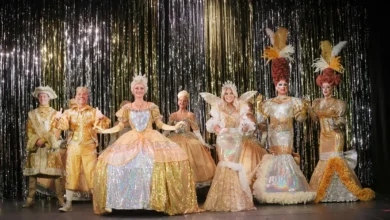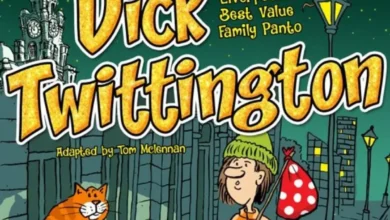
Lost Atoms – A Frantic Exploration of Love and Memory
Frantic Assembly’s Lost Atoms is a raw, physical dive into love, loss and the fragile nature of memory. Written by Anna Jordan (Yen, The Unreturning, Succession), and directed by Frantic’s Scott Graham, this new production fuses movement, light and sound to explore how we remember — and misremember — the people who shape us.
Jess and Robbie (Hannah Sinclair Robinson and Joe Layton) meet in a liminal “No Man’s Land”, where fragments of their past relationship flicker back to life. Each recalls events differently, and as memories collide, truths unravel. Frantic’s signature physicality amplifies the emotional charge.
Marking the company’s 30th anniversary, Lost Atoms reaffirms Frantic Assembly’s commitment to daring new writing and collaborative creation. Tender, funny and devastating, it’s a story about how love changes us — and how, even when it fades, it remains “in every cell.”
Artistic Director Scott Graham discussed with Liverpool Noise’s Steve Kinrade the company’s physical approach, the emotional architecture of the play, and how Lost Atoms captures energy, feeling—and everything in between…
How is Frantic Assembly’s signature physical theatre style being integrated into Lost Atoms to achieve this, particularly in conveying the abstract concepts of love and memory?
I think if we have got it right there is nothing abstract about love and memory. I think the key to that is not simply bombarding an audience with textual information but to invite them to feel the frisson, the tension that exists around a moment. That can be explored and presented through detailed movement that works with the text, often suggesting what is existing underneath or behind words. I want to engage an active audience who lean forward in their seats and are intrigued by a situation. They can recognise the feeling that exists around a moment and, as they do, their heads are filled with words unsaid on stage.

Lost Atoms delves into what it feels like to be in love and what it feels like to remember. How will the performances of Joe Layton and Hannah Sinclair Robinson navigate the shifts between these states, and what challenges did this present during rehearsals?
Hannah and Joe have been with this production from the very beginning. We all shared stories and perspectives about our experiences of love and the vagaries of memory. Writer Anna Jordan and I wanted to explore these themes through a construct of two ex-lovers meeting to make sense of their relationship and how it ended. We wanted their understanding of a definitive truth to be challenged and potentially shattered by being given access to their ex-partner’s perspective on any event. No matter how minutely different that perspective might be it could make all the difference. We had to be clear about the logic of the show.
It was two people meeting in what we called a No Mans Land. From there they held the history of the relationship. They would play out scenes of their younger selves, often disagreeing on details, but these younger selves must not know how things turn out. This means that the versions of themselves in No Mans Land might appear to be wiser but this is the version of themselves that has everything to learn from their meeting. Having done that they realise that the past is a construct, and the future might as well be too. They liberate themselves from any definitive version of events. It was complicated and led to a few questions and melting brains!
The production team includes a set designer, lighting designer, sound designer, costume designer, and music supervisor. How do these individual design elements collaborate to create the “energy and movement and noise and light” mentioned, particularly in representing the emotional landscape of the relationship?
The first thing was to think of memories locked away. They can be retrieved but maybe someone does not want it to be retrieved. The set is a huge set of drawers that might suggest a vault of memories. Then light and sound could suggest how these memories emerge. Do they glow like a treasured event or is the memory a trauma that has been locked away? Memories would escape the drawers, and their sounds would flow from the stage and into the audience. The reference behind this idea was how the ghosts emerge in the film Poltergeist. Each department works closely with the other and can inspire and help bring each other’s ideas to fruition.
Frantic Assembly is celebrating its 30th anniversary with Lost Atoms. How does this production reflect the evolution of the company’s work over the past three decades, while still maintaining its core artistic identity?
I think this show is a reminder of the company’s commitment to new writing and commissioning new plays. We are often considered a movement company and while movement is a very important language within the work it is not the only one.
A core artistic identity is not something I aim for as that identity is subconscious. It is more like your handwriting. It gives you away. Aiming for something ‘Frantic’ feels reductive and limiting.
Is it possible to elaborate on the “multiple imagined futures” that the two characters propel themselves into? Are these presented as distinct scenes, or are they more subtly woven into the fabric of the narrative?
They come after their idea of an agreed past becomes impossible and the implication that our memories are constructed individually. In reality one of them wants to continue the relationship and the other does not. To help them move on they get them to see that accepting various possible futures is the same as accepting various possible pasts. One wants to hold on to the past, and the other accepts that our memory of it will fade. That is not a bad thing. We are who we are because of our time together. We created each other and are made from each other. No matter how distant and dark the memory of each other becomes we remain ‘in every cell.’
Given the exploration of memory and differing perspectives, what research, if any, was conducted into the psychology of memory and its fallibility, and how did this inform the script and direction?
Minimal specific research, really, but many conversations and information picked up over time. Discussions were informal so we never wrote a bank of references.
The title Lost Atoms could refer to fragmented memories or aspects of self that change or disappear within a relationship. Very “quantum”. How does the concept of lost atoms interact with the idea of superposition in the play’s themes? Do we see elements of the relationship’s past or the characters’ identities that are permanently “lost”, as certain realities emerge?
The title came to me suddenly. I did not know what it meant but it felt intriguing and relevant to what we were exploring. Having looked up the phrase, I found it initially connected to experiments that throw up an anomaly and therefore something about the process must have been wrong. All atoms should have been accounted for. I thought this was very interesting considering our focus on the perception that our memories should contain a rigid truth.
Lost Atoms could suggest that the process of remembering is what was creating the anomaly. I do not want to give away a spoiler but there is also a tragic loss at the heart of this play which connects to Lost Atoms. The characters never really get their heads around this loss, and it impacts their relationship.

Given the ambiguity inherent in the play’s portrayal of the relationship, how do you hope the audience will engage with this deliberate uncertainty? Do you aim for them to leave with their own “collapsed” interpretation, or to remain in a state of questioning, much like the nature of quantum reality?
I would always want an audience to leave talking about a production. Not necessarily to be confused about it, however. I don’t think there is anything particularly quantum about Lost Atoms. It is about realising that there are different versions of the past and that our memories fade. Accepting this provides a freedom to look at future memories not met yet. It is not about time travel but about imagination and how we process our emotional connections.
As a co-production with several theatres (Mayflower Southampton, Curve, Lyric Hammersmith Theatre), how has this collaborative process influenced the development and artistic vision of Lost Atoms?
It is vital that the work we make can tour. The basic remit is that it must fit in all the venues of the tour. The responsibility for this lies in the design and therefore, the designer, the production manager and the producer. As artistic director I work closely with them so that I am not asking for the impossible while always looking to push what is possible.
The collaborative element from the venues comes from their enthusiasm and encouragement for the work to engage and thrill their audiences. They are not prescriptive about what that work should be. I feel the work needs to be authentically ours (the core collaborative creative team) and that means the creative process is an intense and intimate experience.
What was the most challenging aspect of bringing Lost Atoms from concept to stage, and conversely, what has been the most rewarding?
Time is always the enemy. Anna Jordan’s script is a knotty, challenging and beautiful work. Wrestling with it and getting to work out the rules and parameters of the world she was creating was crucial and time consuming. In a short rehearsal period this leaves little time to get the work up on its feet. And it is never as simple as that. Even with experienced Frantic performers like Joe Layton and Hannah Sinclair Robinson, we must start at the beginning with all the physicality.
I wanted the performers to be clambering all over the set and Hannah is scared of heights! That was something I did not know on day one! But step by step we overcome these issues and now, what is most rewarding is that it feels like the show belongs to Hannah and Joe. They have worked their socks off to make it look effortless!
Lost Atoms
Tuesday 14 October – Saturday 18 October 2025
Liverpool Playhouse
Tickets







